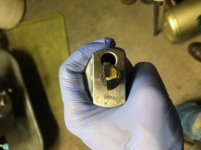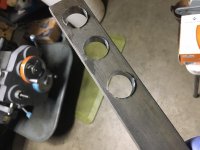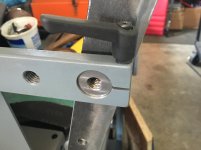steamandsteel
Aluminum
- Joined
- Oct 21, 2017
- Location
- Wichita, KS
Hello,
Trying to simply bore out some holes and get a good finish that's within my specs.
Basically, looking to get around a 1" hole, or just a few tenths under.
Current order of operations:
Centerdrill with 3/16" bit
Drill out with 63/64" bit
Bore to final dimension with brazed carbide bar
The boring bar in my boring head doesn't seem to be giving a decent finish at all, and also has one hell of a spring pass on the upstroke.
Powerfeeding down at 1/2" per minute, probably running 800-1000rpm
Here are some pictures, any thoughts or advice are greatly appreciate.



I did have some decent luck previously with a HSS bit at a 90 degree angle, and a 31/32 bit. However, burned the 31/32 bit and HSS didn't hold up too well.
Trying to simply bore out some holes and get a good finish that's within my specs.
Basically, looking to get around a 1" hole, or just a few tenths under.
Current order of operations:
Centerdrill with 3/16" bit
Drill out with 63/64" bit
Bore to final dimension with brazed carbide bar
The boring bar in my boring head doesn't seem to be giving a decent finish at all, and also has one hell of a spring pass on the upstroke.
Powerfeeding down at 1/2" per minute, probably running 800-1000rpm
Here are some pictures, any thoughts or advice are greatly appreciate.



I did have some decent luck previously with a HSS bit at a 90 degree angle, and a 31/32 bit. However, burned the 31/32 bit and HSS didn't hold up too well.









